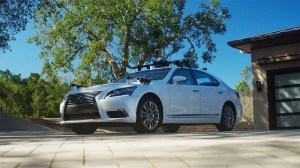Toyota’s newest autonomous research vehicle is expected to learn from its mistakes, adapting to both individual driver behavior and unexpected situations it will likely encounter in real-world driving.
Based on the current Lexus LS 600hL second-generation research model making its debut at the Toyota Research Institute in Palo Alto, California, today is the first developed entirely in-house by the Japanese automaker.
The Gen-2 research vehicle help Toyota take two different approaches to the challenges of self-driving automobiles. That includes both driver assistance technology meant to help a human always drive at their best level, as well as fully autonomous technology that could, eventually, allow a vehicle to operate with no human behind the wheel at any time or place.
The heavily modified Lexus sedan “is a smart vehicle designed to get smarter over time,” said TRI CEO Gill Pratt. “It will learn individual driver habits and abilities and will benefit from shared intelligence from other cars as data gathering, sharing and connectivity technologies advance.”
(Toyota puts old headquarters on the market. Click Here for the story.)
Toyota boasts about being one of the early entrants into autonomous driving, and the automaker notes it received its first patent in the field in 2006. But it slipped behind many key competitors – as well as new players like Google’s Waymo and Tesla – in recent years. In late 2015, it made a major push to get back in the game, creating TRI and hiring some of the most respected specialists in both self-driving vehicles an artificial intelligence, as well as robotics.
That includes Pratt who was previously with DARPA, the high-tech arm of the U.S. Department of Defense. Its DARPA Challenge spurred early development of autonomous and fully driverless technologies.
(Toyota shifting bet from conventional hybrids to plug-ins. Click Here for the story.)
Pratt and his team are pushing into two distinct forms of autonomous technology:
- Guardian systems, that serve as driver alerts, leaving the human in control of the vehicle. These include such systems as automatic emergency braking, and are capable of stepping in, when necessary, to prevent a crash;
- Chauffeur systems take control of the vehicle entirely. So-called Level 4 autonomy is restricted to specific “geo-fenced” areas and conditions, while Level 5 can operate at all times without a driver.
“We believe Guardian can probably be deployed sooner and more widely than Chauffeur, providing high-level driver-assist features capable of helping mitigate collisions and save lives, sooner rather than later,” said Pratt.
In fact, he has told TheDetroitBureau.com that he does not believe the technology yet exists to deliver full, Level 5 functionality, though that challenge is a high priority for the auto industry.
For now, the autonomous Lexus LS will continue to need a driver behind the wheel ready to take control in a hurry, if needed.
The vehicle is equipped with a variety of different sensors, including radar, cameras and LIDAR, a high-definition, 3D laser system that many believe will be critical to full autonomy.
(Click Here for details about Toyota and Suzuki teaming up for tech development.)
Toyota is but the latest maker to develop its own, in-house autonomous vehicle. Ford launched its second-generation Fusion last year. And Waymo debuted a specially modified version of the Chrysler Pacifica minivan during the North American International Auto Show in Detroit in January. In an unusual move, the Google spin-off is now producing all of its own autonomous vehicle sensors, including the LIDAR devices, in a bid to both hasten development and to bring down costs.

